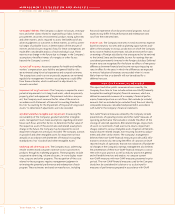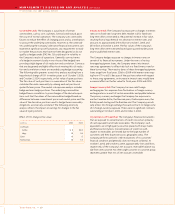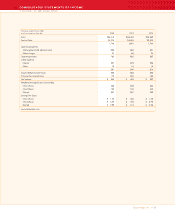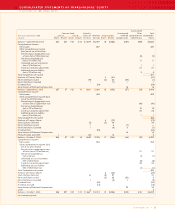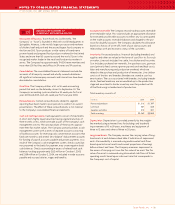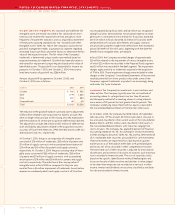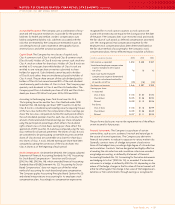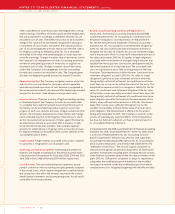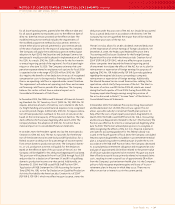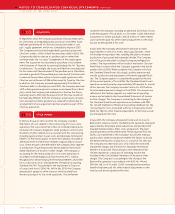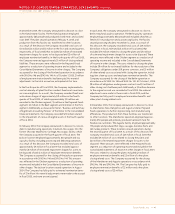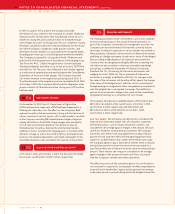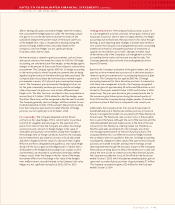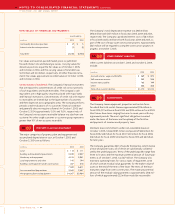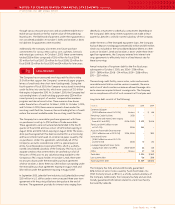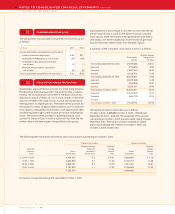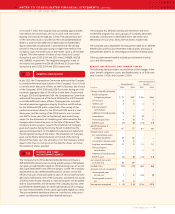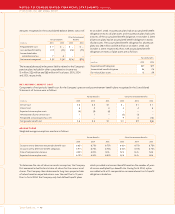Tyson Foods 2005 Annual Report Download - page 40
Download and view the complete annual report
Please find page 40 of the 2005 Tyson Foods annual report below. You can navigate through the pages in the report by either clicking on the pages listed below, or by using the keyword search tool below to find specific information within the annual report.
>> NOTES TO CONSOLIDATED FINANCIAL STATEMENTS (CONTINUED)
TYSON FOODS, INC. 2005 ANNUAL REPORT
Tyson Foods, Inc. >> 38
other comprehensive income (loss) until the hedged item is recog-
nized in earnings. The effect of the derivatives and the hedged items
that are accounted for as a hedge, as defined by SFAS No. 133, are
recorded in cost of sales. The ineffective portion of an instrument’s
change in fair value will be immediately recognized in earnings as
a component of cost of sales. Instruments the Company holds as
part of its risk management activities that do not meet the criteria
for hedge accounting, as defined by SFAS No. 133, as amended,
are marked to fair value with unrealized gains or losses reported
currently in earnings. Changes in market value of derivatives used in
the Company's risk management activities surrounding inventories
on hand or anticipated purchases of inventories or supplies are
recorded in cost of sales. Changes in market value of derivatives
used in the Company's risk management activities surrounding
forward sales contracts are recorded in sales. The Company gener-
ally does not hedge anticipated transactions beyond 12 months.
Revenue Recognition: The Company recognizes revenue when title
and risk of loss are transferred to customers, which is generally
upon delivery based upon terms of sale. Revenue is recognized as
the net amount estimated to be received after deducting estimated
amounts for discounts, trade allowances and product terms.
Litigation Reserves: There are a variety of legal proceedings pending
or threatened against the Company. Accruals are recorded when
it is probable that a liability has been incurred and the amount of
the liability can be estimated reasonably based on current law,
progress of each case, opinions and views of legal counsel and other
advisers, the Company’s experience in similar matters and manage-
ment’s intended response to the litigation. These amounts, which
are not discounted and are exclusive of claims against third parties,
are adjusted periodically as assessment efforts progress or addi-
tional information becomes available. The Company expenses
amounts for administering or litigating claims as incurred. Accruals
for legal proceedings are included in other current liabilities in the
consolidated balance sheets.
Freight Expense: Freight expense associated with products shipped
to customers is recognized in cost of products sold.
Advertising and Promotion Expenses: Advertising and promotion
expenses are charged to operations in the period incurred. Adver-
tising and promotion expenses for fiscal years 2005, 2004 and 2003
were $456 million, $465 million and $504 million, respectively.
Use of Estimates: The consolidated financial statements are pre-
pared in conformity with accounting principles generally accepted
in the United States, which require management to make estimates
and assumptions that affect the amounts reported in the consoli-
dated financial statements and accompanying notes. Actual results
could differ from those estimates.
Recently Issued Accounting Standards and Regulations: In
March 2005, the Financial Accounting Standards Board (FASB)
issued Interpretation No. 47, “Accounting for Conditional Asset
Retirement Obligations,” an interpretation of FASB Statement
No. 143 (the Interpretation). Statement of Financial Accounting
Standards No. 143, “Accounting for Asset Retirement Obligations”
(SFAS No. 143), was issued in June 2001 and requires an entity to
recognize the fair value of a liability for an asset retirement obliga-
tion in the period in which it is incurred if a reasonable estimate of
fair value can be made. SFAS No. 143 applies to legal obligations
associated with the retirement of a tangible long-lived asset that
resulted from the acquisition, construction, development and (or)
the normal operation of a long-lived asset. The associated asset
costs are capitalized as part of the carrying amount of the long-
lived asset. The Interpretation clarifies the term “conditional asset
retirement obligation” as used in SFAS No. 143, refers to a legal
obligation to perform an asset retirement activity in which the
timing and (or) method of settlement are conditional on a future
event that may or may not be within the control of the entity. The
Interpretation requires an entity to recognize a liability for the fair
value of a conditional asset retirement obligation if the fair value
of the liability can be reasonably estimated. Uncertainty about the
timing and (or) method of settlement of a conditional asset retire-
ment obligation should be factored into the measurement of the
liability when sufficient information exists. SFAS No. 143 acknowl-
edges that in some cases, sufficient information may not be
available to reasonably estimate the fair value of an asset retire-
ment obligation. The Interpretation is effective for fiscal years
ending after December 15, 2005. The Company is currently in the
process of evaluating any potential effects of the Interpretation
but does not believe its adoption will have a material impact on
its consolidated financial statements.
In December 2004, the FASB issued Statement of Financial Accounting
Standards No. 123R, “Share-Based Payment” (SFAS No. 123R), which
is a revision of FASB Statement No. 123, “Accounting for Stock-
Based Compensation” (SFAS No. 123). SFAS No. 123R supersedes
Accounting Principles Board (APB) Opinion No. 25, “Accounting for
Stock Issued to Employees,” and amends FASB Statement No. 95,
“Statement of Cash Flows.” The revision requires companies to
measure and recognize compensation expense for all share-based
payments to employees, including grants of employee stock options,
in the financial statements based on the fair value at the date of the
grant. SFAS No. 123R permits companies to adopt its requirements
using either the modified prospective method or the modified
retrospective method. Under the modified prospective method,
compensation cost is recognized beginning with the effective date


